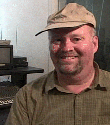|
|
This topic comprises 3 pages: 1 2 3
|
|
Author
|
Topic: Ebert Praises Maxivision 48
|
Mark Lensenmayer
Phenomenal Film Handler

Posts: 1605
From: Upper Arlington, OH
Registered: Sep 1999
|
 posted 04-14-2003 09:33 PM
posted 04-14-2003 09:33 PM




At the end of his review of GHOSTS OF THE ABYSS, Roger Ebert says this:
quote:
Note: I learn that Cameron's next fiction film, his first since "Titanic," will be a feature shot in 3-D. "People are looking for a new way to be stimulated," industry analyst Paul Dergarabedian said in the announcement story.
He is correct about people, but wrong that 3-D is a new way to be stimulated. It is an old way that has never lived up to its promise. If Cameron wants to be a pioneer instead of a retro hobbyist, he should obviously use Maxivision 48, which provides a picture of such startling clarity that it appears to be 3-D in the sense that the screen seems to open a transparent window on reality. "Ghosts of the Abyss" would have been incomparably more powerful in the process.
Maxivision 48 would be cheaper than 3-D, would look dramatically better, would not require those silly glasses, would be backward-compatible for standard theaters, and would allow Cameron to introduce the next step forward in movie projection, rather than returning to the obsolete past. Cameron has the clout and the imagination to make this leap forward, not just for his next film but for an industry that needs something dramatic and new and realizes it isn't going to be digital projection. This is his chance to explore the future of cinema as bravely as he ventured to the ocean floor.
-- Ebert, Roger. "Ghosts of the Abyss Review." Chicago Sun-Times 11 Apr. 2003. 14 Apr. 2003 <http://www.suntimes.com/output/ebert1/wkp-news-ghosts11f.html>.
Citation by EasyBib.Com
Has anyone here seen this process in Action?
More information is available at this website:
Maxivision 48 Website
| IP: Logged
|
|
Bobby Henderson
"Ask me about Trajan."

Posts: 10973
From: Lawton, OK, USA
Registered: Apr 2001
|
 posted 04-14-2003 10:32 PM
posted 04-14-2003 10:32 PM




I would still rather see James Cameron shoot a film in true 65mm/70mm format. We'll probably see peace across the entire middle-east before that ever happens. MaxiVision 48 might be cool. But let's face it. The industry can't even make something as simple as shipping films on 6000' reels ever happen. That's not to mention upping the frame count from 24 to 30fps.
IMHO, a 2 hour movie shot in 3D is a bad idea, even if it is gloriously photographed in IMAX-3D. Many viewers cannot handle viewing 3D for any more than perhaps 45 minutes to an hour, tops.
In normal real-life viewing, the focal plane of our eye sight matches up with the point of convergence (the single point where both of our eyes are aimed). When watching a 3D movie, we focus on the screen, a fixed object. Yet the point of convergence drifts well in front of and behind the screen. Sure, our eyes can process focus and convergence independently. But not for extended times without eye-strain or a headache.
Whatever project James Cameron pursues, I'm probably going to line up to see it anyway. If he shoots a movie in 70mm or IMAX, then he'll almost certainly get a lot of praise from me (provided the imagery isn't botched somehow, which for him would be very unlikely).
| IP: Logged
|
|
Aaron Haney
Master Film Handler
Posts: 265
From: Cupertino, CA, USA
Registered: Jan 2001
|
 posted 04-14-2003 10:56 PM
posted 04-14-2003 10:56 PM




quote:
I would still rather see James Cameron shoot a film in true 65mm/70mm format. We'll probably see peace across the entire middle-east before that ever happens.
Actually, Cameron already has done a project in a 65/70 format -- the Terminator 2 "ride" at the Universal Studios theme park in LA. It was shot in 5 perf 65mm. It's also in 3D, viewed with polarizing glasses. It's very impressive. At one point, two side panels open up to reveal two more screens on either side of the main screen, leaving the audience looking at three side by side 5 perf 70mm images, all showing in 3D. The three screens give the impression that there is a huge room behind the stage, and the screens are just windows looking into it. Characters move back and forth between the screens fairly seamlessly.
The 3D is accomplished in projection using two side by side projectors for each screen. So when the two side screens open up, there are six 5 perf 70mm projectors running in sync at that point.
The T2 "Ultimate Edition" DVD (the one currently available, not the new one which is coming out soon) has a behind the scenes video on the making of this ride. I had always avoided watching this segment until I got a chance to see the ride in person. Then I was very interested in how the show was made. In the video, Cameron and many of his crewmembers praise 70mm for providing such high quality images. They also talk about having to render special effects at very high resolution in order to maintain acceptable image quality in the large format. The camera rigs used on the set were truly massive, yet they were able to construct cranes and dollies that could keep the camera moving quickly in action shots. It's a very impressive production.
| IP: Logged
|
|
Dave Macaulay
Film God

Posts: 2321
From: Toronto, Canada
Registered: Apr 2001
|
 posted 04-14-2003 11:28 PM
posted 04-14-2003 11:28 PM




I think the linked page is a wonderful example of marketing hyperbole!
This process has 3 features:
1) runs at 48fps.
2) uses 3-perf pulldown with a large aperture (like super-35) and thus no analog sound.
3) Active registration - uses marks printed on the film and some system to do what seems to be automatic framing.
48fps: this does make a difference in image quality. Trumbull used 60fps for Showscan 5/70mm, Imax has 48fps-capable ImaxHD 15/70 projectors available (Gordon runs one at Ontario Place) and a film or two have been shot in ImaxHD. Showscan is dead and ImaxHD found no following, probably on cost/benefit grounds in both cases - the film gets expensive!
This (48fps) is hardly a breakthrough, the extra clarity is noticeable but not quite stunning.
The marketing people at Maxivision missed the whole point though - they say it's because the exposure time is shorter giving sharper images with motion. The fluid motion at 48fps versus 24fps comes from having twice as many images of the moving objects rather than sharper individual images, and modern cinema cameras have adjustable shutters that can give quite short exposure times anyway.
3-perf: This is a great idea for 1.85:1 presentation and if the world would forget about 'scope we would probably be running it now. 3-perf is used a fair bit in production. Several TV shows are shot with 3-perf film, this gives a high quality source for HDTV with little waste in that 16:9 format. It's fairly easy to print to 4-perf for 1.85 cinema releases as well.
The problem for the cinemas is that projectors won't do 3-perf and cinemascope isn't likely to go away soon. Making a projector that can do both 3 and 4 perf is a trick, and probably means an electronic projector like the Kinoton E-drive machines.
Losing the analog track is probably reasonable now, digital sound can stand on its own - but the optical centre shift means making a 3/4 perf machine gets more unlikely. (and the web site doesn't hint that such a machine is possible)
Active Registration: What problem does this solution address?
My completely subjective conclusion:
This is a penny stock play, trying to sucker people into investing in vapourware.
They mention that 24fps is possible. This can only be to allow showing cross-printed "normal" 1.85 films to be shown. I can't see film producers stocking double inventory to make their normal 24fps films showable at 3-perf theatres until there are a LOT of them... and I can't see many systems being installed until all popular films are available in 3-perf... classic deadlock.
I can't imaging theatre owners installing this system for the limited appeal of the improved "look" at 48fps.
I can't see a producer making a big-budget film and releasing it only in Maxivision 48, meaning people will be able to see any major film in normal 1.85 24fps... and the improvement at 48fps just isn't that amazing that they will pay much of a premium for it.
Digital projection is coming and Joe Exhibitor is dreading the cost of converting to it. Why bet the bank on another film format?
The active registration thingy seems to be a way to avoid operator screwups, this type of foolproofness is also a selling point for digital projection. Misframing is a pretty benign form of operator incompetence - damaging the film is far more serious (and is a problem that digital projection can actually avoid). This system still has the same easily damaged film, and presumably will require a human to assemble, handle, and thread the film.
Their only possible product seems to be the projector. The cocepts of 48fps and 3-perf pulldown are far from new. I don't see any chance that many will be sold.
Come on over and kick me if I'm proven wrong ![[Smile]](smile.gif)
| IP: Logged
|
|
|
|
|
|
|
|
|
|
|
|
|
|
|
|
|
|
|
|
|
|
|
|
|
|
All times are Central (GMT -6:00)
|
This topic comprises 3 pages: 1 2 3
|
Powered by Infopop Corporation
UBB.classicTM
6.3.1.2
The Film-Tech Forums are designed for various members related to the cinema industry to express their opinions, viewpoints and testimonials on various products, services and events based upon speculation, personal knowledge and factual information through use, therefore all views represented here allow no liability upon the publishers of this web site and the owners of said views assume no liability for any ill will resulting from these postings. The posts made here are for educational as well as entertainment purposes and as such anyone viewing this portion of the website must accept these views as statements of the author of that opinion
and agrees to release the authors from any and all liability.
|

 Home
Home
 Products
Products
 Store
Store
 Forum
Forum
 Warehouse
Warehouse
 Contact Us
Contact Us




 Printer-friendly view of this topic
Printer-friendly view of this topic







![[Smile]](smile.gif)




![[Frown]](frown.gif)






